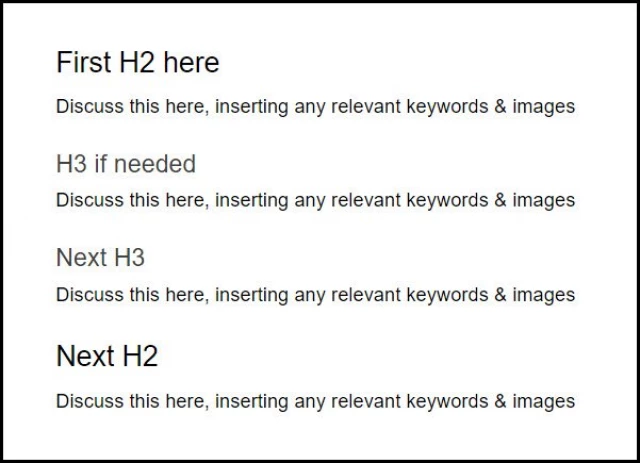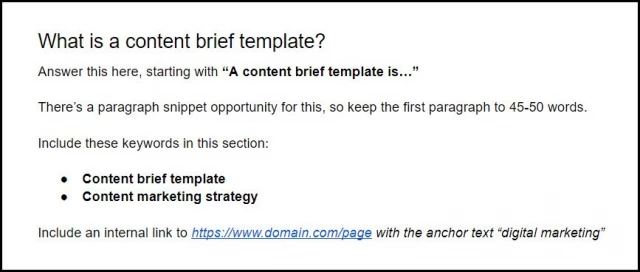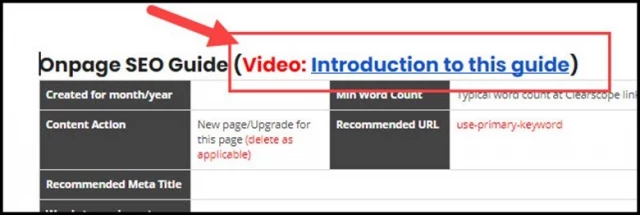How a Content Brief Template Can Level-up Your SEO Content Marketing Strategy

Believe it or not, a content brief template has a gazillion uses!
OK, so I’ve exaggerated a bit, but it’s so flexible that I’m convinced that you can apply it to ANY content marketing strategy.
Not convinced?
Hear me out..
What is a content brief template, anyway?
A content brief template is a structured and detailed document to ensure the writer nails the final content based on your needs and strategy. The more you include in the content brief template, the more likely the writer is to NOT wander from the target.
And we all know how much writers love to go off on a tangent…
(oh look, a chicken!)
Benefits of a content brief template for your content marketing strategy
Once you’ve put in the hard yards of getting a content brief template together (more on that coming up!), the fruits of your labor will shine through in the form of:
- Massive efficiencies
- Usable by anyone
- SEO-optimized
- Instantly duplicatable
- Adaptable to any industry/niche
Content brief templates create massive efficiencies!
We’re all super-busy, right?
And we all seem to be on the hunt for those crazy efficiencies so we don’t have to keep doing the same thing time and time again.
This is especially the case with some kick-ass content planning tools out there.
So, what if I told you that you can create a content brief template that you can apply to ANY piece of content?
While there’s a time-sink at the beginning, and you may need to tweak them as you go, you’ll see huge time and money savings once they’re established.
Don’t contribute to the statistic of employees waiting 5 hours on average per week waiting for expertise help.
It’s simply a case of:
- Choosing the type of template you need
- Filling in each section, and
- Pinging it off to your writer!
Anyone can use the templates
One of your goals should be to produce briefs so anyone can pick them up, understand them, and create an engaging piece of content.
While you may not turn Steve from Accounting into a content writer overnight, you can still give him the tools so he can put the right content in the right places.
You may even have a writer that’s capable to go the whole hog, and:
- Pick the right template
- Optimize it for the topic & keywords
- Write the darn thing!
SEO-Optimized
You more than likely know how much Google loves the use of H1s, H2s and H3s so it can determine the structure of your content and what your content is about.
BUT…
A content brief template makes it much easier to slide target keywords into the content.
It can be really easy to focus on either getting the article in structure in place OR the keyword research, but sacrificing one of the others.
With the template in place, a lot of the work is done for your writer up-front.
Here’s an example…
Let’s say we want to target the keyword, “content brief template.”
Template before:

SEO-optimized template:

Your client/writer is going to LOVE you for doing this for them.
You’ve done the hard work so they don’t have to worry about the keywords as much and can focus on relevant and targeted content… essentially, doing what they do best.
See what I mean about practically anyone being able to write with one of these bad boys?
Duplicatable in a heartbeat
One of the things I love the most about these kick-ass templates, especially with Google Docs, is that you can:
- Pick the one best-suited to your needs
- Make a copy
- Keep the original comments
- Share it with the same people
… and that’s all within a couple of minutes.
You can then fill in the different sections—check below for what section to include—and throw it over to your writer.
It’s then a case of rinsing and repeating over and over to churn out top-level content.
Adaptable to any niche or industry
I challenge you to find me an industry or niche that you can’t apply a content brief template to...
...go on, I’m waiting!
By keeping the original template generic, you can shape it and adapt it to anything.
BUT, the caveat is that the site needs to have a blog i.e. have an online content marketing strategy.
Keep in mind that you should also keep a balance between not making the template too empty so that it’s hard to apply to anything business or topic, but also not making it too niche so that you can’t duplicate it.
Now I’ve got your attention with the benefits, what the hell do you include in the template?
Key features of a content brief template
The awesome thing about a content brief template is that you can shape it however you need to suit your style, blog or business.
Google Docs is your best bet for banding the template about. While it can be a bit clunky in places, it’s much more user friendly than Word, and it’s so simple to share.
No matter your chosen format, there are a few things you should definitely include:
- Guide to the template
- Due date
- Word count
- Meta title
- H1
- Meta description
- Target keywords
- Competitors
- Internal links to include
- Article roadmap
1. Start with a template guide
If your content brief template is going to confuse your writer to hell and back, why not record a video and throw it up at the top of the template?

That way, the writer has zero excuses if they goof-up a section.
In fact, you can go one better and include further videos for different sections of the template.
Doing this will help keep the writer’s attention span and they can bite off each section as they need.
This is better than a 20-minute video that sends them into dreamland.
2. Due date
MANAGE EXPECTATIONS!
Writers are a bit like plumbers… you never want to employ one that isn’t busy.
So, give the writer a specific date for when they need to have the content back to you by.
Top tip: Give yourself some wiggle room for editing before it needs uploading or if you need to send it on to a client.
3. Word count
Having a generic 1,000 words per article just doesn’t work, especially when there are ample tools out there to show you how many words the competition has around your chosen topic.
What if ALL your competition has written a monster skyscraper of 6,000 words? Your miniscule 1k article is going to be drowning in an instant.
Again, this is about managing expectations and telling your writer what the minimum expected word count is.
4. Meta title

Including a meta title depends on your business structure.
For example:
- Include: You’re a B2B digital marketing agency creating briefs for your clients
- Exclude: Company briefing an in-house team member to write the content
Since the meta title doesn’t sit on-page exactly, it’s more of an SEO essential rather than something your writer needs to be worried about.
Still, it could help your writer know the exact angle, especially if you write a perfect SEO page title.
5. Recommended H1
The ideal H1 is similar to the meta title, BUT it avoids the writer creating one and totally getting it wrong.
It works in conjunction with the targeted keywords, for you to populate the H1 with:
- As many of the targeted keywords as possible; and
- Ensuring it makes sense
Essentially, you’re maximizing the SEO ‘juice’ at the very top of the article.
Along with the meta title and meta description, Google’s spiders are going to come across these parts of your page first and start to build an idea of what your page is about.
6. Meta description
Think of the meta description as the first part of your page organic traffic will see, which we all know is super important for being digitally discoverable.
It’s the descriptor of your page, so it needs to be:
- Descriptive
- Contain keywords
- Less than 940 pixels or 160 characters
If you don’t hit the last point above, it gets chopped off, just like what’s happened to our pals over at Yoast:

Again, you have a couple of options here:
- Include a list of keywords for the writer to include
- Create & optimize the meta description yourself
Tip: Option 2 is the better choice, especially since you’re providing massive value to the reader
7. Target keywords
Through your rigorous keyword research (and we all know how important that is!), you’ll likely have an insane amount of keywords you feel you should include.
But, you should make it easier on yourself...
Aim to include a maximum of 10 keywords.
Otherwise, both you and your writer are likely to over optimize the content for keywords, and not write for humans.
It’ll become less engaging, bland and read like it’s written by a robot.
You’ll both also take far too long over the content and stagnate your entire content marketing strategy.
Essentially, this keywords section serves a couple of purposes:
- Checking mechanism for you to see if you have the keywords in the right places
- Reference point for the writer, to help shape the content and for them to include the keywords throughout
8. Competitor URLs
While I always advise writers to check the competition AFTER they’ve written their content, including 2 or 3 URLs to competitors’ content gives the writer an idea of the type of content needed.
It also helps them to stay on track in terms of what content to include, such as:
- “What is…” type questions
- Image-heavy content
- If an infographic is needed
Basically, the writer should do a better job than the competition, so you need to tell them who the competition is.
9. Internal links to include
Repeat after me…
Internal links are insanely important!
Google relies on them to paint a picture of how you’ve constructed your site, so creating topic clusters (silos) takes the hard work away from Google’s spiders…
...and allows the Big G to rank your pages (and, therefore, your site) appropriately.
So, make sure you include the following:
- Page to link from
- Page to link to
- Anchor text
Also, ensure the first link is the most important one for your cluster or silo.
Here’s an example of a template you can use:

It doesn’t have to be any more important than that!
10. Article roadmap
This is where you create the “roadmap” for the writer, filling it out with keywords in the headers and shaping how you want the article to look.
Make it clear and obvious that this is where the writer does their thang.
Also, feel free to write guidance in the roadmap for what you want from each section.
For example:
It’s time to fly, young Padawan
While you can pick up a content brief template from numerous places, I feel the trick is to curate your own.
Sure, a basic one will get your content marketing strategy off to start, but make sure you adapt and change it as you evolve your strategy.
My best piece of advice is to create the template so it holds your writer’s hand through every step of the process.
That way, they do what they do best… write!
Bio
Chris McDonald is a UK freelancer over at Webris, specializing in content marketing. He secretly plays rugby for England (In his dreams! It’s good to have goals, right?)
He’s passionate about the power of the written word, but when not tapping away at the keyboard, he’s into all things health & wellness, advocating to be kind and thoughtful of others
(especially his kids).
Header Photo by Campaign Creators on Unsplash
How To Guides
- How to optimise your content for topical relevance using SEO Scout's content grader
- How to Fine-tune Your Content by Adding Missing Long-tail Keywords
- How to find the FAQ keywords you can easily rank for
- Content Pruning: How To Consolidate Pages with Little to no Search Visibility
- How to Find and Fix Thin Content Pages for Your Website’s SEO
- How to Find New SEO Content Opportunities, Consistently
Related Blogs
- How to Refresh Your Content in 2021 & Beat Content Decay
- The 13 Best SEO Tools for Content Optimization & Analysis
- 12 Best Content Brief Generators & Planning Tools for Content Marketers
- How a Content Brief Template Can Level-up Your SEO Content Marketing Strategy
- Is Your Content Working? - An Analytical Guide
- How to Write a Blog Post Outline
